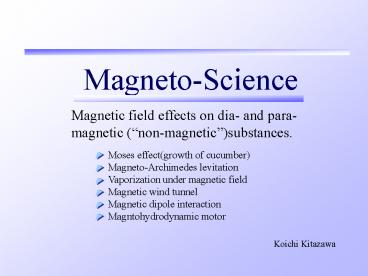MagnetoScience PowerPoint PPT Presentation
1 / 21
Title: MagnetoScience
1
Magneto-Science
Magnetic field effects on dia- and para-magnetic
(non-magnetic)substances.
Moses effect(growth of cucumber) Magneto-Archimede
s levitation Vaporization under magnetic
field Magnetic wind tunnel Magnetic dipole
interaction Magntohydrodynamic motor
Koichi Kitazawa
2
Introduction
Diamagnetic material
Energy
Repelled from magnetic field
Force
Paramagnetic material
c Magnetic susceptibility - , m0
Permeability of vacuum 4p10-7 A/m, B
Magnetic flux density T
Attracted from magnetic field
Magnetic energy is very small comparing with the
energy of room temperature RT.
Higher field
B 10 T
Electric, permanent magnet
10 times
Force
100 times!
B 1 T
(?B 2)
3
Cryo-cooler cooled magnet
Maximum field10 T Room temperature bore f 100
mm
Sumitomo Heavy Industries, Ltd.
Fig. Distributions of magnetic field B and the
index of magnetic force B?B/?z
Liquid Helium free
4
The Moses Effect the Reversed Moses Effect
Height difference
Fig. Photographs of surface profiles of liquid
samples water (a) and CuSO4 aqueous solution (b)
in a magnetic field of 10 T.
N. Hirota et al., Jpn. J. Appl. Phys., 34 (1995)
L991
Liquid surface profile was changed by strong
magnetic field.
5
Enhanced Moses Effect
By lying two immiscible liquids
Making ?r smaller
Fig. Profile of the interface between an organic
solvent (upper) and a copper sulfate aqueous
solution (lower). Bmax 0.56 T
Large interface height difference by week
magnetic fields.
H. Sugawara, et al., J. Appl. Phys. 79 (8), 4721-
4723(1996)
The deformation of interface profile by permanent
magnet.
6
Magnetic Levitation Diamagnetic Levitation
Fig. Water ball(left) and frog(right) levitating
in the bore of a hybrid magnet.
The balance of the gravity and magnetic
(repulsive) force
http//www.sci.kun.nl/hfml/froglev.html
c.f. B(?B/?z)max.lt 500 T2/m (for ordinary
superconducting magnets)
It is necessary to use a ultrahigh field for
diamagnetic levitation.
7
Magneto-Archimedes Levitation
Considering magnetic buoyant force from atomsphere
(a)
H2O
- -9.010-6
- (diamagnetic)
(b)
Making the susceptibility difference larger
Small B?B/?z is required. Paramagnetic substances
can be levitated.
1 cm
Fig. Water(a) and paramagnetic CuSO4aq.(b)
levitating in the bore of a s.c. magnet.
Y. Ikezoe et al., Nature, 393 (1998) 749
Magnetic levitation with usual superconducting
magnet Levitation of paramagnetic substances.
8
(No Transcript)
9
Magnetic Separation
Stable positions of the substances in the
magnetic field are determined by
Pressure of oxygen gas,
Magnetic field distribution,
Susceptibility of substances,
Density of substances, etc.
Fig. Photographs of separated sugar salt in 32
atm oxygen gas(upper), and the glasses of
different colors in MnCl2aq.(lower).
Magnetic separation is possible by utilizing
Magneto-Archimedes principle.
Y. Ikezoe et al., Trans. Mater. Res. Soc. Jpn.,
25 1 (2000) 77
10
Magnetic separation of NaCl CuSO4
?????
11
Magnetic Wind Tunnel
cO21.8010-6
Paramagnetic oxygen
Susceptibility of air
Magnetic force
B
Thigh
Tlow
c large
c small
f large
f small
Heating
x
flow
heater
Fig. Creation of magnetic wind tunnel under 8 T
field.
Airflow was induced magnetically.
12
Enhancement of oxygen gas dissolution rate into
water
v gt 1 cm
Fig. The amount of oxygen dissolved in water at
15? in a field at 0 T, 2 T, and 4 T. It is seen
that the rate of dissolution is enhanced
significantly by the magnetic field while the
equilibrium solubility remains the same.
Fig. The mechanism proposed for the
magneto-enhancement of the dissolution rate of
oxygen into water. The susceptibility of water
near the surface becomes slightly larger due to
the higher concentration of paramagnetic oxygen
relative to that of water in the bulk.
Magnetically induced convection accelerates
oxygen dissolution.
13
Interaction between magnetically induced dipoles
S
S
N
N
S
N
Magnetic fields
Feeble magnetic materials in high magnetic fields
Weak magnet
Interaction between permanent magnets
N
attractive
S
repulsive
repulsive
attractive
repulsive
14
Energy of interaction
Interaction energy between magnetic moments
r
µa(b)magnetic moments of particle a and b Am2
r distance between magnetic moments m
Energy of this interaction changes by the
square of magnetic field intensity
This interaction between feeble magnetic
materials should be observed under high magnetic
fields
15
Experimental
Samples
Polyester thread
Pd (Paramagnetic)
Samples
Au (Diamagnetic)
Shape of the sample f1mm5mm (rod shape)
Superconducting coil
Samples were fixed at z150 mm
Schematic figure of the experimental set up
16
Experimental results
Pd-Pd
Au-Pd
Au-Au
0T
0T
0T
1.0mm
1.0mm
6T
6T
6T
Direction of magnetic fields
1.0mm
1.0mm
Direction of induced dipoles
repulsive
repulsive
attractive
Attractive and repulsive interactions between
magnetically induced dipoles in feeble magnetic
materials were observed
17
Interaction in many bodies system
Observation of the modification of particles
arrangement
Samples
Glass particles(spherical)
Magnet bore
diameter 0.8mm
Samples
CCD camera
Cu particles(Spherical)
diameter 1.0mm
mirror
MnCl2 aq
Center of field
media
MnCl2 aqueous solution (2040wt )
Schematic figure of experimental set up
Paramagnetic
18
Results
glass in MnCl2aq 20wt
glass in MnCl2aq 40wt
Cu in MnCl2aq 40wt
0T
0T
0T
5.5T
4.7T
2.5T
B
Magnetically induced dipoles
Particles were connected like a chain due to the
interaction
19
(No Transcript)
20
MagnetoHydrodynamic Motor
2025 mm
B (//g)
Glass vessel
FL
Electrode (width20 mm)
40 mm
I1.0 A
V 50 V, I 1.0 A
Monochlorobenzene(upper) CuSO4 aq.(lower)
Fig. CuSO4aq. was rotating in a glass vessel.
Lorentz force on aqueous solution rotated the
liquid.
21
Summary
Creating a new process utilizing magnetic field
Process control
Moses effect, Enhanced Moses effect Magneto-Archim
edes levitation Convection control
Material process
Crystal growth in levitating state Magnetic
orientation
Separation technique
Magneto-Archimedes separation
Poccoble application to the Nano-technology!

